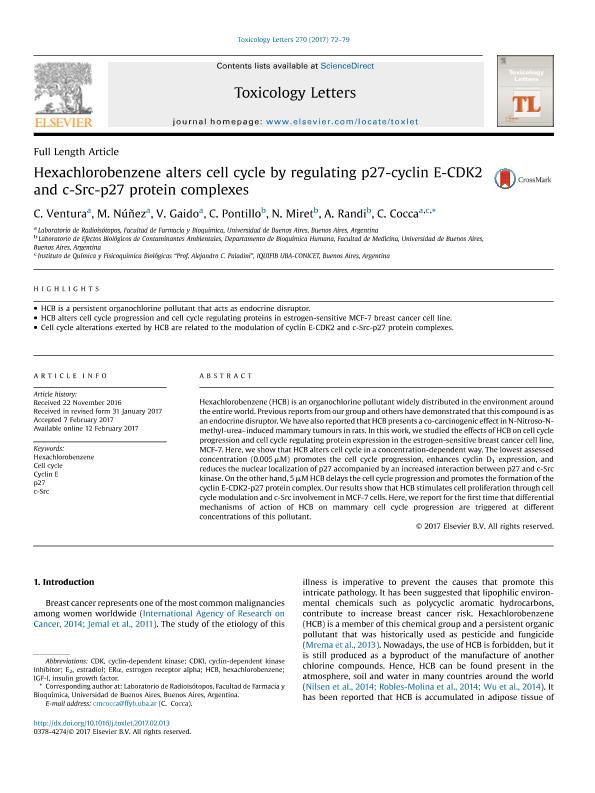Artículo
Hexachlorobenzene alters cell cycle by regulating p27-cyclin E-CDK2 and c-Src-p27 protein complexes
Ventura, Clara ; Núñez, M.; Gaido, Vanesa Elisabeth; Pontillo, Carolina Andrea
; Núñez, M.; Gaido, Vanesa Elisabeth; Pontillo, Carolina Andrea ; Miret, Noelia Victoria
; Miret, Noelia Victoria ; Randi, Andrea Silvana
; Randi, Andrea Silvana ; Cocca, Claudia Marcela
; Cocca, Claudia Marcela
 ; Núñez, M.; Gaido, Vanesa Elisabeth; Pontillo, Carolina Andrea
; Núñez, M.; Gaido, Vanesa Elisabeth; Pontillo, Carolina Andrea ; Miret, Noelia Victoria
; Miret, Noelia Victoria ; Randi, Andrea Silvana
; Randi, Andrea Silvana ; Cocca, Claudia Marcela
; Cocca, Claudia Marcela
Fecha de publicación:
03/2017
Editorial:
Elsevier Ireland
Revista:
Toxicology Letters
ISSN:
0378-4274
Idioma:
Inglés
Tipo de recurso:
Artículo publicado
Clasificación temática:
Resumen
Hexachlorobenzene (HCB) is an organochlorine pollutant widely distributed in the environment around the entire world. Previous reports from our group and others have demonstrated that this compound is as an endocrine disruptor. We have also reported that HCB presents a co-carcinogenic effect in N-Nitroso-N-methyl-urea–induced mammary tumours in rats. In this work, we studied the effects of HCB on cell cycle progression and cell cycle regulating protein expression in the estrogen-sensitive breast cancer cell line, MCF-7. Here, we show that HCB alters cell cycle in a concentration-dependent way. The lowest assessed concentration (0.005 μM) promotes the cell cycle progression, enhances cyclin D1 expression, and reduces the nuclear localization of p27 accompanied by an increased interaction between p27 and c-Src kinase. On the other hand, 5 μM HCB delays the cell cycle progression and promotes the formation of the cyclin E-CDK2-p27 protein complex. Our results show that HCB stimulates cell proliferation through cell cycle modulation and c-Src involvement in MCF-7 cells. Here, we report for the first time that differential mechanisms of action of HCB on mammary cell cycle progression are triggered at different concentrations of this pollutant.
Palabras clave:
C-Src
,
Cell Cycle
,
Cyclin E
,
Hexachlorobenzene
,
P27
Archivos asociados
Licencia
Identificadores
Colecciones
Articulos(IQUIFIB)
Articulos de INST.DE QUIMICA Y FISICO-QUIMICA BIOLOGICAS "PROF. ALEJANDRO C. PALADINI"
Articulos de INST.DE QUIMICA Y FISICO-QUIMICA BIOLOGICAS "PROF. ALEJANDRO C. PALADINI"
Articulos(OCA HOUSSAY)
Articulos de OFICINA DE COORDINACION ADMINISTRATIVA HOUSSAY
Articulos de OFICINA DE COORDINACION ADMINISTRATIVA HOUSSAY
Citación
Ventura, Clara; Núñez, M.; Gaido, Vanesa Elisabeth; Pontillo, Carolina Andrea; Miret, Noelia Victoria; et al.; Hexachlorobenzene alters cell cycle by regulating p27-cyclin E-CDK2 and c-Src-p27 protein complexes; Elsevier Ireland; Toxicology Letters; 270; 3-2017; 72-79
Compartir
Altmétricas



